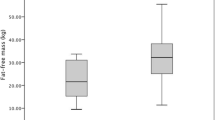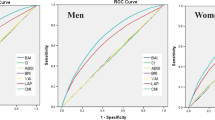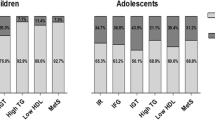Abstract
Introduction
This cross-sectional study investigates the association between insulin resistance (IR) and serum uric acid (sUA) and relative fat (RFM) and lean mass (RLM) profiles in children with chronic kidney disease (CKD).
Material and methods
RLM and RFM were assessed by bioimpedance spectroscopy in 41 children and adolescents. Normal weight obesity (NWO) was defined as normal height-age body mass index and RFM >85th percentile, according to age and sex. Homeostatic model assessment of insulin resistance (HOMA-IR) level >95th percentile, according to sex and pubertal stage, and sUA >7 mg/dl were used to define IR and hyperuricemia, respectively.
Results
High RFM (15 patients) and NWO (7 patients) were associated with higher HOMA-IR in total (p < 0.001) and normal-weight patients (p = 0.004), respectively. RFM was positively and RLM negatively correlated to HOMA-IR (rs = 0.500, p = 0.001 and rs = −0.539, p < 0.001, respectively) and sUA (rs = 0.370, p = 0.017 and rs = −0.325, p = 0.038, respectively), while sUA was positively correlated to HOMA-IR (rs = 0.337, p = 0.031). Hyperuricemia (16 patients) was positively associated with higher RFM and HOMA-IR (p = 0.001 and p = 0.010, respectively). The correlation between sUA and HOMA-IR lost significance after adjustment for RFM. In logistic regression analysis, a 5% increase in RFM was associated with IR (11 patients) independently of the age, sex, sUA, and CKD stage in both total (OR 2.174, 95% CI 1.115–4.225) and normal-weight (OR 3.504, 95% CI 1.110–11.123) patients.
Conclusion
Children with high RFM, including those presenting NWO, are at risk for IR regardless of CKD stage. RFM is probably the mediator of the link between sUA and IR.




Similar content being viewed by others
References
Spoto B, Pisano A, Zoccali C (2016) Insulin resistance in chronic kidney disease: a systematic review. Am J Physiol Renal Physiol 311:F1087–F1108
Kahn SE, Hull RL, Utzschneider KM (2006) Mechanisms linking obesity to insulin resistance and type 2 diabetes. Nature 444:840–846
Romero-Corral A, Somers VK, Sierra-Johnson J, Korenfeld Y, Boarin S, Korinek J, Jensen MD, Parati G, Lopez-Jimenez F (2010) Normal weight obesity: a risk factor for cardiometabolic dysregulation and cardiovascular mortality. Eur Heart J 31:737–746
Wiklund P, Törmäkangas T, Shi Y, Wu N, Vainionpää A, Alen M, Cheng S (2017) Normal-weight obesity and cardiometabolic risk: a 7-year longitudinal study in girls from prepuberty to early adulthood. Obesity (Silver Spring) 25:1077–1082
Sgambat K, Roem J, Mitsnefes M, Portale AA, Furth S, Warady B, Moudgil A (2018) Waist-to-height ratio, body mass index, and cardiovascular risk profile in children with chronic kidney disease. Pediatr Nephrol 33:1577–1583
Mak RH (2008) Insulin and its role in chronic kidney disease. Pediatr Nephrol 23:355–362
Weaver DJ Jr (2019) Uric acid and progression of chronic kidney disease. Pediatr Nephrol 34:801–809
Johnson RJ, Nakagawa T, Jalal D, Sánchez-Lozada LG, Kang DH, Ritz E (2013) Uric acid and chronic kidney disease: which is chasing which? Nephrol Dial Transplant 28:2221–2228
Kanbay M, Jensen T, Solak Y, Le M, Roncal-Jimenez C, Rivard C, Lanaspa MA, Nakagawa T, Johnson RJ (2016) Uric acid in metabolic syndrome: from an innocent bystander to a central player. Eur J Intern Med 29:3–8
Seyed-Sadjadi N, Berg J, Bilgin AA, Grant R (2017) Visceral fat mass: Is it the link between uric acid and diabetes risk? Lipids Health Dis 16:142
Schwartz GJ, Muñoz A, Schneider MF, Mak RH, Kaskel F, Warady BA, Furth SL (2009) New equations to estimate GFR in children with CKD. J Am Soc Nephrol 20:629–637
Kurtoglu S, Mazicioglu MM, Ozturk A, Hatipoglu N, Cicek B, Ustunbas HB (2010) Body fat reference curves for healthy Turkish children and adolescents. Eur J Pediatr 169:1329–1335
d'Annunzio G, Vanelli M, Pistorio A, Minuto N, Bergamino L, Iafusco D, Lorini R, Diabetes Study Group of the Italian Society for Pediatric Endocrinology and Diabetes (2009) Insulin resistance and secretion indexes in healthy Italian children and adolescents: a multicentre study. Acta Biomed 80:21–28
Buyan N, Bideci A, Ozkaya O, Ortac E, Bakkaloglu S, Gonen S, Peru H, Soylemezoglu O, Cinaz P (2006) Leptin and resistin levels and their relationships with glucose metabolism in children with chronic renal insufficiency and undergoing dialysis. Nephrology (Carlton) 11:192–196
Lai HL, Kartal J, Mitsnefes M (2007) Hyperinsulinemia in pediatric patients with chronic kidney disease: the role of tumor necrosis factor-α. Pediatr Nephrol 22:1751–1756
Canpolat N, Caliskan S, Sever L, Guzeltas A, Kantarci F, Candan C, Civilibal M, Kasapcopur O, Arisoy N (2012) Glucose intolerance: Is it a risk factor for cardiovascular disease in children with chronic kidney disease? Pediatr Nephrol 27:627–635
Lindblad YT, Axelsson J, Bárány P, Celsi G, Lindholm B, Qureshi AR, Carrea A, Canepa A (2008) Hyperinsulinemia and insulin resistance, early cardiovascular risk factors in children with chronic kidney disease. Blood Purif 26:518–525
Patel HP, Saland JM, Ng DK, Jiang S, Warady BA, Furth SL, Flynn JT (2017) Waist circumference and body mass index in children with chronic kidney disease and metabolic, cardiovascular, and renal outcomes. J Pediatr 191:133–139
Lalan S, Jiang S, Ng DK, Kupferman F, Warady BA, Furth S, Mitsnefes MM (2018) Cardiometabolic risk factors, metabolic syndrome, and chronic kidney disease progression in children. J Pediatr 202:163–170
Becker B, Kronenberg F, Kielstein JT, Haller H, Morath C, Ritz E, Fliser D, MMKD Study Group (2005) Renal insulin resistance syndrome, adiponectin and cardiovascular events in patients with kidney disease: the mild and moderate kidney disease study. J Am Soc Nephrol 16:1091–1098
Marlais M, Coward RJ (2015) Paediatrics, insulin resistance and the kidney. Pediatr Nephrol 30:1217–1224
Manios Y, Moschonis G, Kourlaba G, Bouloubasi Z, Grammatikaki E, Spyridaki A, Hatzis C, Kafatos A, Fragiadakis GA (2008) Prevalence and independent predictors of insulin resistance in children from Crete, Greece: the children study. Diabet Med 25:65–72
Savva SC, Tornaritis M, Savva ME, Kourides Y, Panagi A, Silikiotou N, Georgiou C, Kafatos A (2000) Waist circumference and waist-to-height ratio are better predictors of cardiovascular disease risk factors in children than body mass index. Int J Obes Relat Metab Disord 24:1453–1458
Blüher S, Molz E, Wiegand S, Otto KP, Sergeyev E, Tuschy S, L'Allemand-Jander D, Kiess W, Holl RW, Adiposity Patients Registry Initiative and German Competence Net Obesity (2013) Body mass index, waist circumference, and waist-to-height ratio as predictors of cardiometabolic risk in childhood obesity depending on pubertal development. J Clin Endocrinol Metab 98:3384–3393
Lin TY, Lim PS, Hung SC (2018) Normal-weight obesity and clinical outcomes in nondiabetic chronic kidney disease patients: a cohort study. Am J Clin Nutr 107:664–672
Srikanthan P, Karlamangla AS (2011) Relative muscle mass is inversely associated with insulin resistance and prediabetes. Findings from the Third National Health and Nutrition Examination Survey. J Clin Endocrinol Metab 96:2898–28903
Siew ED, Pupim LB, Majchrzak KM, Shintani A, Flakoll PJ, Ikizler TA (2007) Insulin resistance is associated with skeletal muscle protein breakdown in non-diabetic chronic hemodialysis patients. Kidney Int 71:146–152
Price SR, Gooch JL, Donaldson SK, Roberts-Wilson TK (2010) Muscle atrophy in chronic kidney disease results from abnormalities in insulin signaling. J Ren Nutr 20:S24–S28
Daenen K, Andries A, Mekahli D, Van Schepdael A, Jouret F, Bammens B (2019) Oxidative stress in chronic kidney disease. Pediatr Nephrol 34:975–991
Gondouin B, Jourde-Chiche N, Sallee M, Dou L, Cerini C, Loundou A, Morange S, Berland Y, Burtey S, Brunet P, Guieu R, Dussol B (2015) Plasma xanthine oxidase activity is predictive of cardiovascular disease in patients with chronic kidney disease, independently of uric acid levels. Nephron 131:167–174
Kubota M (2019) Hyperuricemia in children and adolescents: present knowledge and future directions. J Nutr Metab 2019:3480718
Sakou II, Psaltopoulou T, Sergentanis TN, Karavanaki K, Karachaliou F, Ntanasis-Stathopoulos I, Tzanninis S, Sdogou T, Greydanus D, Tsitsika A (2015) Insulin resistance and cardiometabolic risk factors in obese children and adolescents: a hierarchical approach. J Pediatr Endocrinol Metab 28:589–596
Beavers KM, Beavers DP, Serra MC, Bowden RG, Wilson RL (2009) Low relative skeletal muscle mass indicative of sarcopenia is associated with elevations in serum uric acid levels: findings from NHANES III. J Nutr Health Aging 13:177–182
Masuo K, Kawaguchi H, Mikami H, Ogihara T, Tuck ML (2003) Serum uric acid and plasma norepinephrine concentrations predict subsequent weight gain and blood pressure elevation. Hypertension 42:474–480
Sirota JC, McFann K, Targher G, Johnson RJ, Chonchol M, Jalal DI (2013) Elevated serum uric acid levels are associated with non-alcoholic fatty liver disease independently of metabolic syndrome features in the United States: liver ultrasound data from the National Health and Nutrition Examination Survey. Metabolism 62:392–399
Glantzounis GK, Tsimoyiannis EC, Kappas AM, Galaris DA (2005) Uric acid and oxidative stress. Curr Pharm Des 11:4145–4151
De Oliveira EP, Burini RC (2012) High plasma uric acid concentration: causes and consequences. Diabetol Metab Syndr 4:12
Ferrando B, Gomez-Cabrera MC, Salvador-Pascual A, Puchades C, Derbré F, Gratas-Delamarche A, Laparre L, Olaso-Gonzalez G, Cerda M, Viosca E, Alabajos A, Sebastiá V, Alberich-Bayarri A, García-Castro F, Viña J (2018) Allopurinol partially prevents disuse muscle atrophy in mice and humans. Sci Rep 8:3549
Tsushima Y, Nishizawa H, Tochino Y, Nakatsuji H, Sekimoto R, Nagao H, Shirakura T, Kato K, Imaizumi K, Takahashi H, Tamura M, Maeda N, Funahashi T, Shimomura I (2013) Uric acid secretion from adipose tissue and its increase in obesity. J Biol Chem 288:27138–27149
Karava V, Printza N, Dotis J, Demertzi D, Antza C, Kotsis V, Papachristou F, Stabouli S (2019) Body composition and arterial stiffness in children with chronic kidney disease. Pediatr Nephrol 34:1253–1260
Derbre F, Ferrando B, Gomez-Cabrera MC, Sanchis-Gomar F, Martinez-Bello VE, Olaso-Gonzalez G, Diaz A, Gratas-Delamarche A, Cerda M, Viña J (2012) Inhibition of xanthine oxidase by allopurinol prevents skeletal muscle atrophy: role of p38 MAPKinase and E3 ubiquitin ligases. PLoS One 7:e46668
Sanchis-Gomar F, Pareja-Galeano H, Perez-Quilis C, Santos-Lozano A, Fiuza-Luces C, Garatachea N, Lippi G, Lucia A (2015) Effects of allopurinol on exercise-induced muscle damage: new therapeutic approaches? Cell Stress Chaperones 20:3–13
Madero M, Rodríguez Castellanos FE, Jalal D, Villalobos-Martín M, Salazar J, Vazquez-Rangel A, Johnson RJ, Sanchez-Lozada LG (2015) A pilot study on the impact of a low fructose diet and allopurinol on clinic blood pressure among overweight and prehypertensive subjects: a randomized placebo controlled trial. J Am Soc Hypertens 9:837–844
Soletsky B, Feig DI (2012) Uric acid reduction rectifies prehypertension in obese adolescents. Hypertension 60:1148–1156
Talma H, Chinapaw MJ, Bakker B, HiraSing RA, Terwee CB, Altenburg TM (2013) Bioelectrical impedance analysis to estimate body composition in children and adolescents: a systematic review and evidence appraisal of validity, responsiveness, reliability and measurement error. Obes Rev 14:895–905
Canpolat N, Caliskan S, Sever L, Tasdemir M, Ekmekci OB, Pehlivan G, Shroff R (2013) Malnutrition and its association with inflammation and vascular disease in children on maintenance dialysis. Pediatr Nephrol 28:2149–2156
Broers NJH, Canaud B, Dekker MJE, van der Sande FM, Stuard S, Wabel P, Kooman JP (2020) Three compartment bioimpedance spectroscopy in the nutritional assessment and the outcome of patients with advanced or end stage kidney disease: What have we learned so far? Hemodial Int 4:148–161
Milani GP, Groothoff JW, Vianello FA, Fossali EF, Paglialonga F, Consolo S, Edefonti A, Consonni D, van Harskamp D, van Goudoever JB, Schierbeek H, Agostoni C, Oosterveld MJS (2018) Bioimpedance spectroscopy imprecisely assesses lean body mass in pediatric dialysis patients. J Pediatr Gastroenterol Nutr 67:533–537
Author information
Authors and Affiliations
Corresponding author
Ethics declarations
All procedures performed were in accordance with the ethical standards of the institutional research committee and with the 1964 Helsinki declaration and its later amendments or comparable ethical standards. Informed consent was obtained from all individual participants included in the study.
Conflict of interest
The authors declare that they have no conflicts of interest.
Additional information
Publisher’s note
Springer Nature remains neutral with regard to jurisdictional claims in published maps and institutional affiliations.
Rights and permissions
About this article
Cite this article
Karava, V., Dotis, J., Kondou, A. et al. Association between relative fat mass, uric acid, and insulin resistance in children with chronic kidney disease. Pediatr Nephrol 36, 425–434 (2021). https://doi.org/10.1007/s00467-020-04716-y
Received:
Revised:
Accepted:
Published:
Issue Date:
DOI: https://doi.org/10.1007/s00467-020-04716-y




